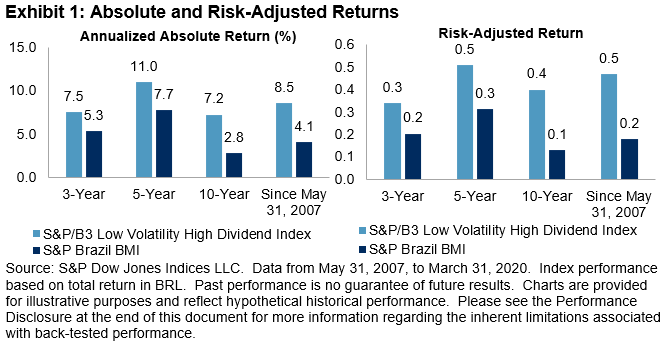S&P Global Offerings
Featured Topics
Featured Products
Events
S&P Global Offerings
Featured Topics
Featured Products
Events
S&P Global Offerings
Featured Topics
Featured Products
Events
Featured Products
Ratings & Benchmarks
By Topic
Market Insights
About S&P Global
Corporate Responsibility
Culture & Engagement
Investor Relations
Featured Products
Ratings & Benchmarks
By Topic
Market Insights
About S&P Global
Corporate Responsibility
Culture & Engagement
Investor Relations
S&P Global Offerings
Featured Topics
Featured Products
Events
Language
S&P Dow Jones Indices — 22 Mar, 2021
By Maria Sanchez and Gaurav Sinha
EXECUTIVE SUMMARY
For investors who seek higher dividend yield and lower volatility for better risk-adjusted returns, S&P Dow Jones Indices has proposed a two-step constituent screening method. In this paper, we discuss how this analysis can be applied to Brazilian equity markets using the S&P/B3 Low Volatility High Dividend Index(opens in a new tab).

1. INTRODUCTION
Almost one year after launching the S&P/B3 Low Volatility High Dividend Index, we examine the potential advantage of incorporating a low volatility screen into a high-dividend-yield portfolio. We also compare the S&P/B3 Low Volatility High Dividend Index to other S&P Dividend Indices in the Brazilian equity market across various aspects such as sector composition, dividend yield, and historical return, among others.
Historically, the percentage of dividend payers in Brazil has ranged between 71% and 92%, making it a favorable environment for implementing dividend-focused strategies. In Brazil, S&P Dow Jones Indices has three different dividend-focused strategies, using different constructions and targeting different objectives:
The highest-yielding stocks in high-yield strategies often come with greater portfolio volatility, and Brazil is no exception. Therefore, an income strategy may require some form of volatility management for portfolio construction.
 DOWNLOAD FULL ARTICLE > (opens in a new tab)
DOWNLOAD FULL ARTICLE > (opens in a new tab)
Content Type
Theme
Segment
Language
